Growth, Yield, and Agronomic Use Efficiency of Delayed Sown Wheat under Slow-Release Nitrogen Fertilizer and Seeding Rate
Abstract
1. Introduction
2. Materials and Methods
2.1. Experimental Site
2.2. Experimental Details
2.3. Experimental Material
2.4. Crop Husbandry
2.5. Observations and Measurements
2.5.1. Growth and Yield-Related Traits
2.5.2. Physiological Attributes
2.5.3. Biochemical Attributes
2.5.4. Statistical Analysis
3. Results
3.1. Growth and Yield
3.2. Physiological and Photosynthetic Activities
3.3. Grain and Straw Nitrogen Content/Nutrient Uptake
3.4. Agronomic Efficiency and Nitrogen Partial Factor Productivity
4. Discussion
5. Conclusions
Author Contributions
Funding
Institutional Review Board Statement
Informed Consent Statement
Data Availability Statement
Conflicts of Interest
References
- Ghafoor, I.; Habib-ur-Rahman, M.; Ali, M.; Afzal, M.; Ahmed, W.; Gaiser, T.; Ghaffar, A. Slow-release nitrogen fertilizers enhance growth, yield, NUE in wheat crop and reduce nitrogen losses under an arid environment. Environ. Sci. Pollut. Res. 2021, 28, 43528–43543. [Google Scholar] [CrossRef] [PubMed]
- Ramzan, Y.; Hafeez, M.B.; Khan, S.; Nadeem, M.; Saleem-ur-Rahman; Batool, S.; Ahmad, J. Biofortification with Zinc and Iron Improves the Grain Quality and Yield of Wheat Crop. Int. J. Plant Prod. 2020, 14, 501–510. [Google Scholar] [CrossRef]
- Rehman, A.; Farooq, M.; Ullah, A.; Nadeem, F.; Im, S.Y.; Park, S.K.; Lee, D.J. Agronomic Biofortification of Zinc in Pakistan: Status, Benefits, and Constraints. Front. Sustain. Food Syst. 2020, 4, 276. [Google Scholar] [CrossRef]
- Peake, A.S.; Bell, K.L.; Fischer, R.A.; Gardner, M.; Das, B.T.; Poole, N.; Mumford, M. Cultivar × Management Interaction to Reduce Lodging and Improve Grain Yield of Irrigated Spring Wheat: Optimising Plant Growth Regulator Use, N Application Timing, Row Spacing and Sowing Date. Front. Plant Sci. 2020, 11, 401. [Google Scholar] [CrossRef] [PubMed]
- Farooq, M.; Rehman, A.; Pisante, M. Sustainable Agriculture and Food Security. In Innovations in Sustainable Agriculture; Springer: Cham, Switzerland, 2019; pp. 3–24. [Google Scholar] [CrossRef]
- Haider, F.U.; Virk, A.L.; Rehmani, M.I.A.; Skalicky, M.; Ata-ul-Karim, S.T.; Ahmad, N.; Soufan, W.; Brestic, M.; Sabagh, A.E.L.; Liqun, C. Integrated Application of Thiourea and Biochar Improves Maize Growth, Antioxidant Activity and Reduces Cadmium Bioavailability in Cadmium-Contaminated Soil. Front. Plant Sci. 2022, 12, 3194. [Google Scholar] [CrossRef]
- Wang, F.; He, Z.; Sayre, K.; Li, S.; Si, J.; Feng, B.; Kong, L. Wheat cropping systems and technologies in China. Field Crop. Res. 2009, 111, 181–188. [Google Scholar] [CrossRef]
- Dai, X.; Xiao, L.; Jia, D.; Kong, H.; Wang, Y.; Li, C.; Zhang, Y.; He, M. Increased plant density of winter wheat can enhance nitrogen–uptake from deep soil. Plant Soil 2014, 384, 141–152. [Google Scholar] [CrossRef]
- Hawkesford, M.J. Reducing the reliance on nitrogen fertilizer for wheat production. J. Cereal Sci. 2014, 59, 276–283. [Google Scholar] [CrossRef]
- Zheng, W.; Zhang, M.; Liu, Z.; Zhou, H.; Lu, H.; Zhang, W.; Yang, Y.; Li, C.; Chen, B. Combining controlled-release urea and normal urea to improve the nitrogen use efficiency and yield under wheat-maize double cropping system. Field Crop. Res. 2016, 197, 52–62. [Google Scholar] [CrossRef]
- Loyce, C.; Meynard, J.M.; Bouchard, C.; Rolland, B.; Lonnet, P.; Bataillon, P.; Bernicot, M.H.; Bonnefoy, M.; Charrier, X.; Debote, B.; et al. Interaction between cultivar and crop management effects on winter wheat diseases, lodging, and yield. Crop. Prot. 2008, 27, 1131–1142. [Google Scholar] [CrossRef]
- Fageria, N.K.; Baligar, V.C. Enhancing Nitrogen Use Efficiency in Crop Plants. Adv. Agron. 2005, 88, 97–185. [Google Scholar] [CrossRef]
- Lu, D.; Lu, F.; Pan, J.; Cui, Z.; Zou, C.; Chen, X.; He, M.; Wang, Z. The effects of cultivar and nitrogen management on wheat yield and nitrogen use efficiency in the North China Plain. Field Crop. Res. 2015, 171, 157–164. [Google Scholar] [CrossRef]
- Shah, F.; Coulter, J.A.; Ye, C.; Wu, W. Yield penalty due to delayed sowing of winter wheat and the mitigatory role of increased seeding rate. Eur. J. Agron. 2020, 119, 126120. [Google Scholar] [CrossRef]
- Suarez-Tapia, A.; Kucheryavskiy, S.V.; Christensen, B.T.; Thomsen, I.K.; Rasmussen, J. Limitation of multi-elemental fingerprinting of wheat grains: Effect of cultivar, sowing date, and nutrient management. J. Cereal Sci. 2017, 76, 76–84. [Google Scholar] [CrossRef]
- Dai, X.; Wang, Y.; Dong, X.; Qian, T.; Yin, L.; Dong, S.; Chu, J.; He, M. Delayed sowing can increase lodging resistance while maintaining grain yield and nitrogen use efficiency in winter wheat. Crop. J. 2017, 5, 541–552. [Google Scholar] [CrossRef]
- Xiao, D.; Moiwo, J.P.; Tao, F.; Yang, Y.; Shen, Y.; Xu, Q.; Liu, J.; Zhang, H.; Liu, F. Spatiotemporal variability of winter wheat phenology in response to weather and climate variability in China. Mitig. Adapt. Strateg. Glob. Change 2015, 20, 1191–1202. [Google Scholar] [CrossRef]
- Rasmussen, I.S.; Thorup-Kristensen, K. Does earlier sowing of winter wheat improve root growth and N uptake? Field Crop. Res. 2016, 196, 10–21. [Google Scholar] [CrossRef]
- Yin, L.; Dai, X.; He, M. Delayed sowing improves nitrogen utilization efficiency in winter wheat without impacting yield. Field Crop. Res. 2018, 221, 90–97. [Google Scholar] [CrossRef]
- Maharjan, B.; Venterea, R.T.; Rosen, C. Fertilizer and Irrigation Management Effects on Nitrous Oxide Emissions and Nitrate Leaching. Agron. J. 2014, 106, 703–714. [Google Scholar] [CrossRef]
- Yao, H.; Zhang, Y.; Yi, X.; Hu, Y.; Luo, H.; Gou, L.; Zhang, W. Plant density alters nitrogen partitioning among photosynthetic components, leaf photosynthetic capacity and photosynthetic nitrogen use efficiency in field-grown cotton. Field Crop. Res. 2015, 184, 39–49. [Google Scholar] [CrossRef]
- Foulkes, M.J.; Hawkesford, M.J.; Barraclough, P.B.; Holdsworth, M.J.; Kerr, S.; Kightley, S.; Shewry, P.R. Identifying traits to improve the nitrogen economy of wheat: Recent advances and future prospects. Field Crop. Res. 2009, 114, 329–342. [Google Scholar] [CrossRef]
- Naz, M.Y.; Sulaiman, S.A. Slow release coating remedy for nitrogen loss from conventional urea: A review. J. Control. Release 2016, 225, 109–120. [Google Scholar] [CrossRef] [PubMed]
- Altaf, A.; Zhu, X.; Zhu, M.; Quan, M.; Irshad, S.; Xu, D.; Aleem, M.; Zhang, X.; Gull, S.; Li, F.; et al. Effects of Environmental Stresses (Heat, Salt, Waterlogging) on Grain Yield and Associated Traits of Wheat under Application of Sulfur-Coated Urea. Agronomy 2021, 11, 2340. [Google Scholar] [CrossRef]
- Azeem, B.; Kushaari, K.; Man, Z.B.; Basit, A.; Thanh, T.H. Review on materials & methods to produce controlled release coated urea fertilizer. J. Control. Release 2014, 181, 11–21. [Google Scholar] [CrossRef]
- Shivay, Y.S.; Prasad, R.; Pal, M. Effect of nitrogen levels and coated urea on growth, yields and nitrogen use efficiency in aromatic rice. J. Plant Nutr. 2016, 39, 875–882. [Google Scholar] [CrossRef]
- Beig, B.; Niazi, M.B.K.; Jahan, Z.; Hussain, A.; Zia, M.H.; Mehran, M.T. Coating materials for slow release of nitrogen from urea fertilizer: A review. J. Plant Nutr. 2020, 43, 1510–1533. [Google Scholar] [CrossRef]
- Chen, J.; Lü, S.; Zhang, Z.; Zhao, X.; Li, X.; Ning, P.; Liu, M. Environmentally friendly fertilizers: A review of materials used and their effects on the environment. Sci. Total Environ. 2018, 613–614, 829–839. [Google Scholar] [CrossRef]
- Manzoor, S.; Habib-Ur-Rahman, M.; Haider, G.; Ghafoor, I.; Ahmad, S.; Afzal, M.; Nawaz, F.; Iqbal, R.; Yasin, M.; Haq, T.U.; et al. Biochar and slow-releasing nitrogen fertilizers improved growth, nitrogen use, yield, and fiber quality of cotton under arid climatic conditions. Environ. Sci. Pollut. Res. 2022, 29, 13742–13755. [Google Scholar] [CrossRef]
- Estefan, G.; Sommer, R.; Ryan, J. Methods of soil, plant, and water analysis. In A Manual for the West Asia and North Africa Region; International Center for Agricultural Research in the Dry Areas (ICARDA): Beirut, Lebanon, 2013; pp. 1–244. [Google Scholar]
- Walkley, A.; Black, I. An examination of the Degtjareff method for determining soil organic matter, and a proposed modification of the chromic acid titration method. Soil Sci. 1934, 37, 29–38. [Google Scholar] [CrossRef]
- Bremner, J.M.; Mulvaney, C.S. Total nitrogen. In Methods of Soil Analysis; Page, A.L., Miller, R.H., Keeny, D.R., Eds.; American Society of Agronomy and Soil Science Society of America: Madison, WI, USA, 1982. [Google Scholar]
- Olsen, S.R.; Cole, C.V.; Watanabe, F.S.; Dean, L.A. Estimation of Available Phosphorus in Soils by Extraction with Sodium. In U.S. Department of Agriculture Circular No. 939; Banderis, A.D., Barter, D.H., Anderson, K., Eds.; Agricultural and Advisor; U.S. Department of Agriculture: Washington, DC, USA, 1954. [Google Scholar]
- Richards, L.A. Diagnosis and Improvement of Saline Sodic and Alkali Soils; US Department of Agriculture: Washington, DC, USA, 1954. [Google Scholar]
- Markwell, J.; Osterman, J.C.; Mitchell, J.L. Calibration of the Minolta SPAD-502 leaf chlorophyll meter. Photosynth. Res. 1995, 46, 467–472. [Google Scholar] [CrossRef]
- Sáez-Plaza, P.; Navas, M.J.; Wybraniec, S.; Michałowski, T.; Asuero, A.G. An Overview of the Kjeldahl Method of Nitrogen Determination. Part II. Sample Preparation, Working Scale, Instrumental Finish, and Quality Control. Crit. Rev. Anal. Chem. 2013, 43, 224–272. [Google Scholar] [CrossRef]
- Wang, C.; Lv, J.; Coulter, J.A.; Xie, J.; Yu, J.; Li, J.; Zhang, J.; Tang, C.; Niu, T.; Gan, Y. Slow-Release Fertilizer Improves the Growth, Quality, and Nutrient Utilization of Wintering Chinese Chives (Allium tuberosum Rottler ex Spreng.). Agronomy 2020, 10, 381. [Google Scholar] [CrossRef]
- Wang, Q.; Li, F.; Zhao, L.; Zhang, E.; Shi, S.; Zhao, W.; Song, W.; Vance, M.M. Effects of irrigation and nitrogen application rates on nitrate nitrogen distribution and fertilizer nitrogen loss, wheat yield and nitrogen uptake on a recently reclaimed sandy farmland. Plant Soil 2010, 337, 325–339. [Google Scholar] [CrossRef]
- Dimkpa, C.O.; Fugice, J.; Singh, U.; Lewis, T.D. Development of fertilizers for enhanced nitrogen use efficiency—Trends and perspectives. Sci. Total Environ. 2020, 731, 139113. [Google Scholar] [CrossRef]
- Gudge, A.; Rawat, G.S.; Jat, S.L.; Tiwari, S. Impact of nitrogen management on physiological parameter of maize under conservation agriculture (Zea mays L.). J. Pharmacogn. Phytochem. 2019, 8, 2123–2128. [Google Scholar]
- Thind, H.S.; Singh, B.; Pannu, R.P.S.; Singh, Y.; Singh, V.; Gupta, R.K.; Vashistha, M.; Singh, J.; Kumar, A. Relative performance of neem (Azadirachta indica) coated urea vis-à-vis ordinary urea applied to rice on the basis of soil test or following need based nitrogen management using leaf colour chart. Nutr. Cycl. Agroecosyst. 2010, 87, 1–8. [Google Scholar] [CrossRef]
- Ahmad, N.; Virk, A.L.; Hussain, S.; Hafeez, M.B.; Haider, F.U.; Rehmani, M.I.A.; Yasir, T.A.; Asif, A. Integrated application of plant bioregulator and micronutrients improves crop physiology, productivity and grain biofortification of delayed sown wheat. Environ. Sci. Pollut. Res. 2022, 29, 52534–52543. [Google Scholar] [CrossRef]
- Ghafoor, I.; ur Rahman, M.H.; Hasnain, M.U.; Ikram, R.M.; Khan, M.A.; Iqbal, R.; Hussain, M.I.; Sabagh, A. El Effect of slow-release nitrogenous fertilizers on dry matter accumulation, grain nutritional quality, water productivity and wheat yield under an arid environment. Sci. Rep. 2022, 12, 14783. [Google Scholar] [CrossRef]
- Gupta, M.; Attri, M.; Sharma, B.C.; Thakur, N.P.; Sharma, R.; Kour, S. Efficacy of neem and zinc coated urea on productivity and economics of wheat (Triticum aestivum). J. Plant Nutr. 2022, 46, 1270–1282. [Google Scholar] [CrossRef]
- Iqbal, J.; Hayat, K.; Hussain, S.; Ali, A.; Ahmad, M.; Haji, A.; Bakhsh, A.; Khan, G. Effect of Seeding Rates and Nitrogen Levels on Yield and Yield Components of Wheat (Triticum aestivum L.). Pak. J. Nutr. 2012, 11, 531–536. [Google Scholar] [CrossRef]
- Suganya, S.; Appavu, K.; Vadivel, A. Relative efficiency of neem coated urea products for rice grown in different soils. Asian J. Soil Sci. 2007, 2, 29–34. [Google Scholar]
- Yuan, L.; Zhang, Z.; Cao, X.; Wu, L. Polyester sulfur-coated urea (PSCU) application enhances brown rice iron concentrations in two alkaline soils. J. Sci. Food Agric. 2022, 102, 1040–1046. [Google Scholar] [CrossRef] [PubMed]
- Rehman, A.; Nawaz, M.; Chattha, M.U.; Khan, I.; Chattha, M.B.; Hussain, F.; Ayub, M.A. Neem Coated Urea Improves the Productivity, Nitrogen Use Efficiency and Economic Return of Wheat Crop Crop reporting services View project Individual and Concurrent Environmental Stresses in Plants: Consequences, Tolerance Mechanisms and Mitigation Strategies View projec. Int. J. Agric. Biol. 2021, 26, 450–460. [Google Scholar] [CrossRef]
- Rehman, H.U.; Asghar, M.G.; Ikram, R.M.; Hashim, S.; Hussain, S.; Irfan, M.; Mubeen, K.; Ali, M.; Alam, M.; Ali, M.; et al. Sulphur coated urea improves morphological and yield characteristics of transplanted rice (Oryza sativa L.) through enhanced nitrogen uptake. J. King Saud Univ.—Sci. 2022, 34, 101664. [Google Scholar] [CrossRef]
- Liao, Z.; Zeng, H.; Fan, J.; Lai, Z.; Zhang, C.; Zhang, F.; Wang, H.; Cheng, M.; Guo, J.; Li, Z.; et al. Effects of plant density, nitrogen rate and supplemental irrigation on photosynthesis, root growth, seed yield and water-nitrogen use efficiency of soybean under ridge-furrow plastic mulching. Agric. Water Manag. 2022, 268, 107688. [Google Scholar] [CrossRef]
- Geng, J.; Liu, Z.; Zhang, M.; Shi, Y.; Zhu, Q.; Sun, Y.; Zhou, H.; Li, C.; Yang, Y.; Geng, J. Improving crop yields, nitrogen use efficiencies, and profits by using mixtures of coated controlled-released and uncoated urea in a wheat-maize system. Field Crop. Res. 2017, 205, 106–115. [Google Scholar] [CrossRef]
- Joshi, A.; Gupta, J.K.; Choudhary, S.K.; Paliwal, D.K. Efficiency of different Nitrogen Source, doses and Split application on growth and yield of maize (Zea mays L.) in the Malwa region of Madhya Pradesh. IOSR J. Agric. Vet. Sci. 2014, 7, 39–42. [Google Scholar] [CrossRef]
- Mustafa, A.; Athar, F.; Khan, I.; Chattha, M.U.; Nawaz, M.; Shah, A.N.; Mahmood, A.; Batool, M.; Aslam, M.T.; Jaremko, M.; et al. Improving crop productivity and nitrogen use efficiency using sulfur and zinc-coated urea: A review. Front. Plant Sci. 2022, 13, 942384. [Google Scholar] [CrossRef]
- Ali, M.; Maqsood, M.A.; Azizl, T.; Awan, M.I. Neem (Azadirachta indica) oil coated urea improves nitrogen use efficiency and maize growth in an alkaline calcareous soil. Pak. J. Agric. Sci. 2020, 57, 675–684. [Google Scholar]
- Gangurde, A.B.; Thakare, R.; Ashwini Gangurde, C.B.; Patil, T.; Chaudhari, R. Effect of neem coated urea on nutrient availability, yield attributing characters and yield of pearl millet on vertisol. J. Pharmacogn. Phytochem. 2018, 7, 2146–2149. [Google Scholar]
- Bana, R.; Shivay, Y. Productivity of summer forage crops and their effect on succeeding basmati rice (Oryza sativa) in conjunction with phosphogypsum-enriched urea. Indian J. Agron. 2012, 57, 24–31. [Google Scholar]
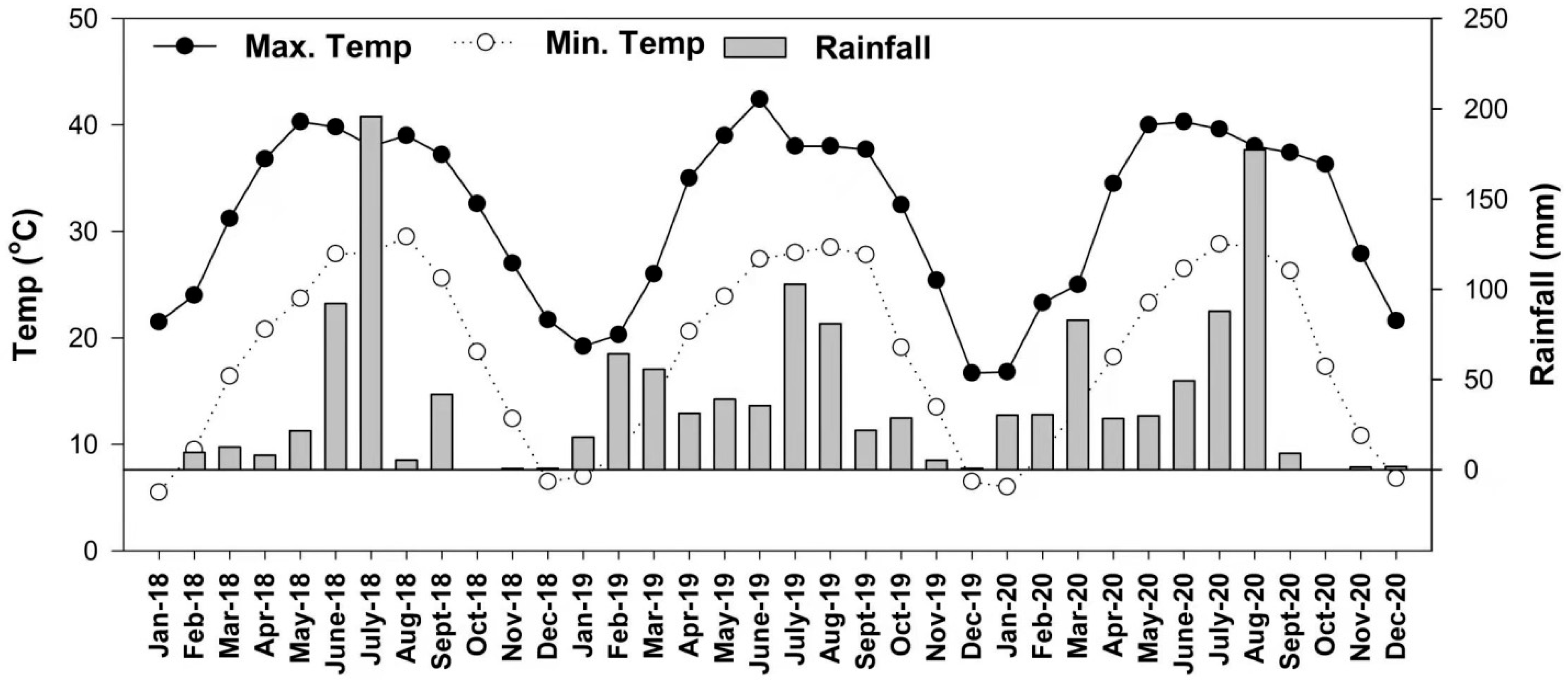
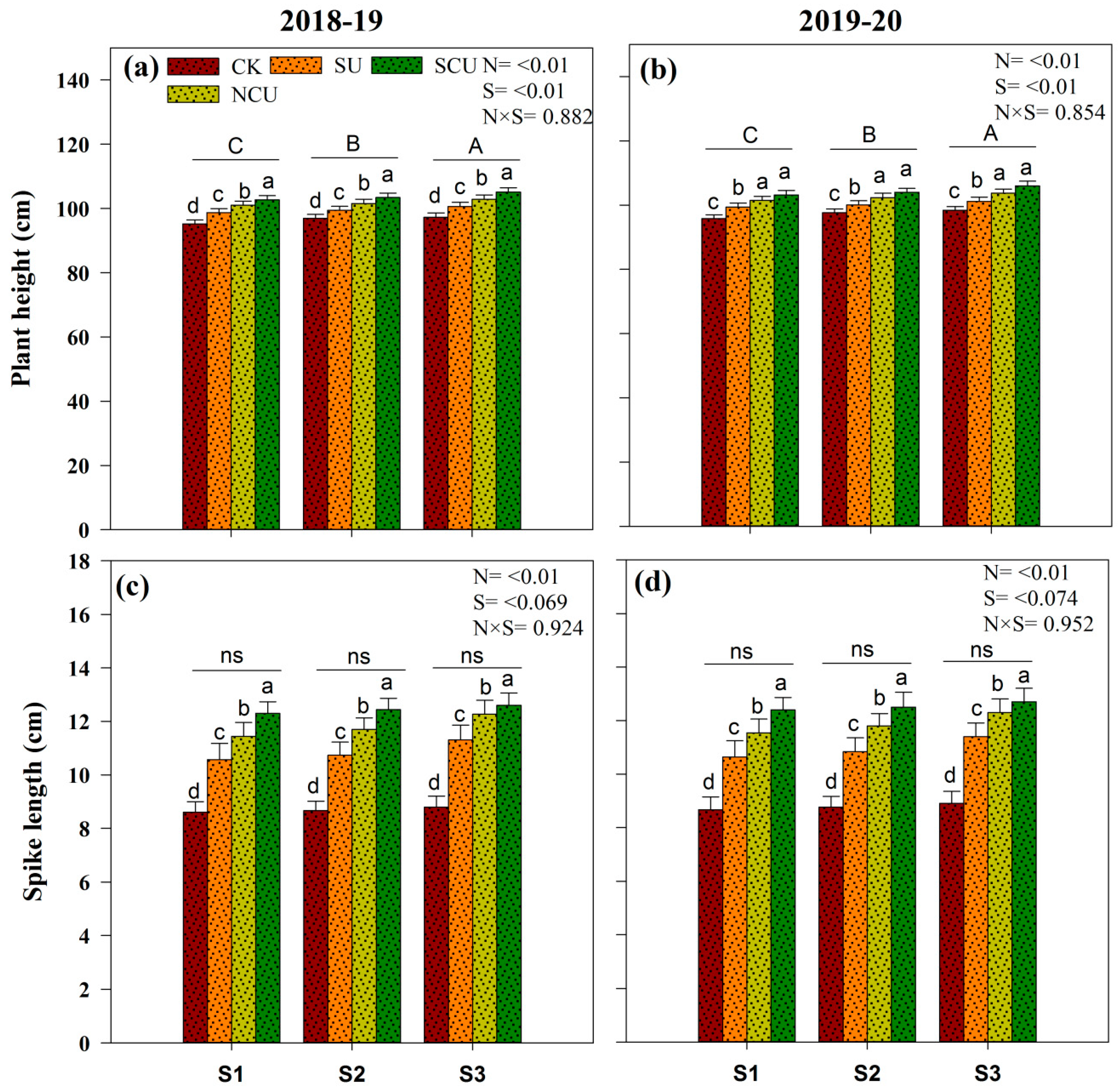
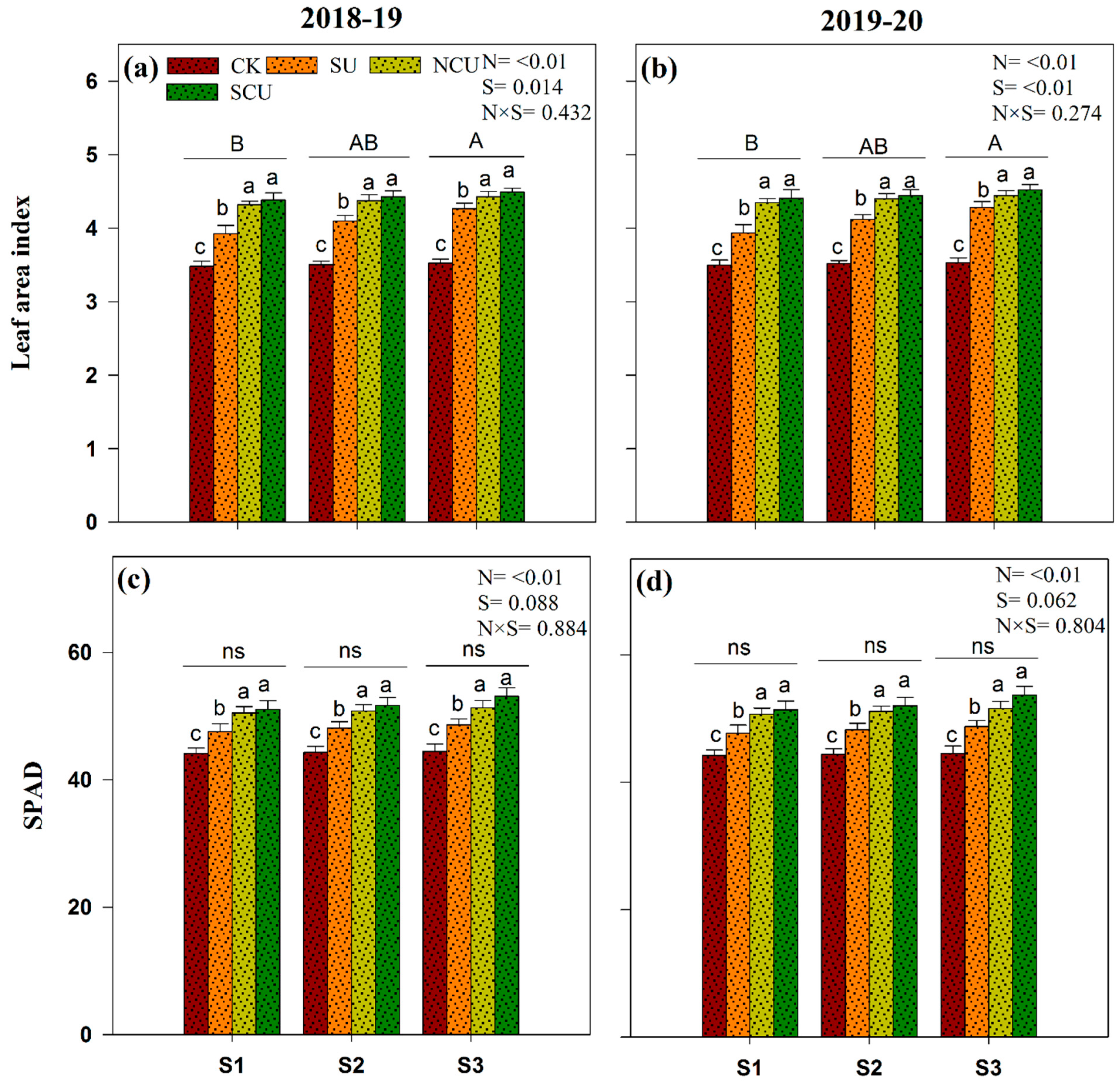

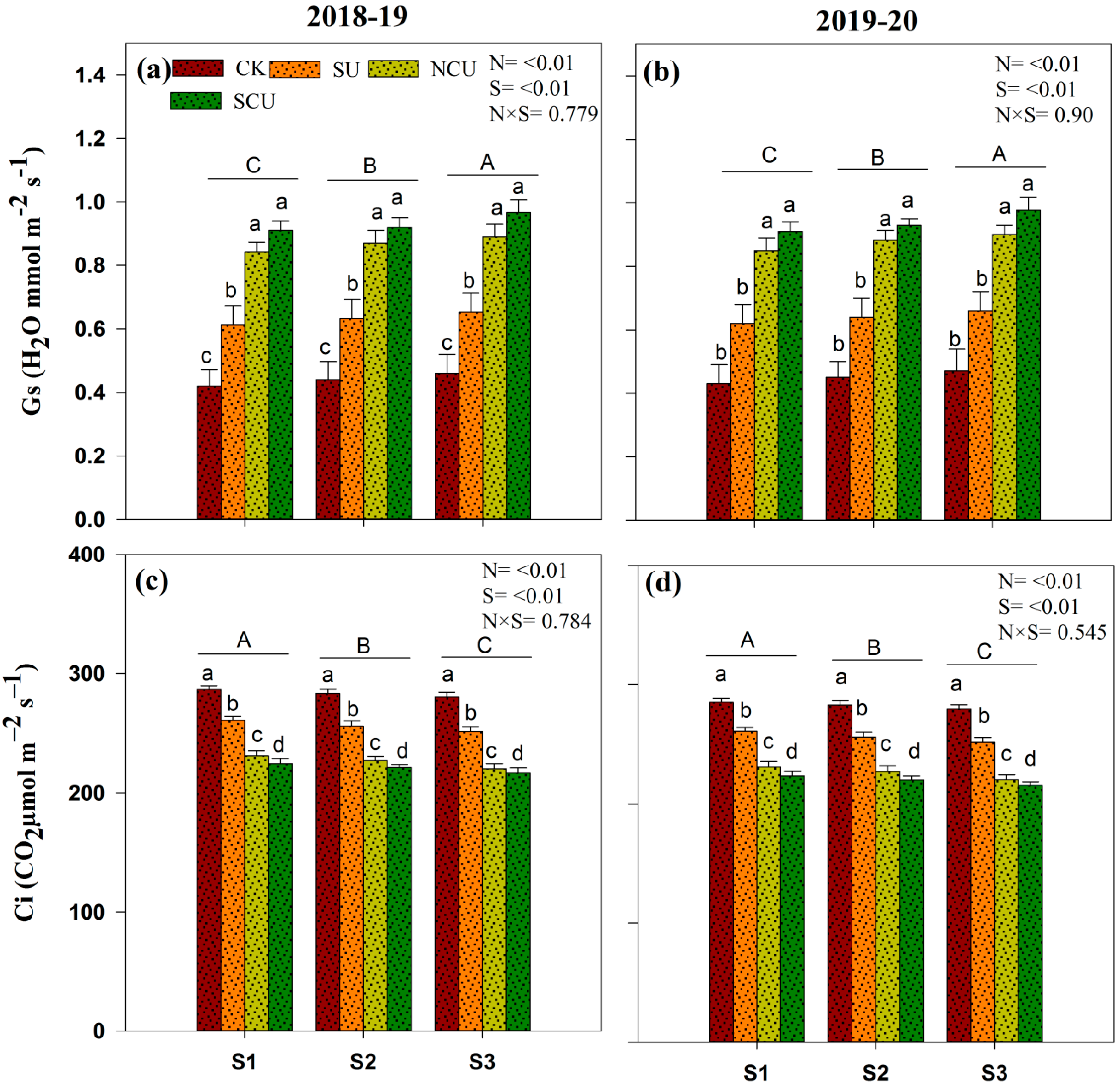
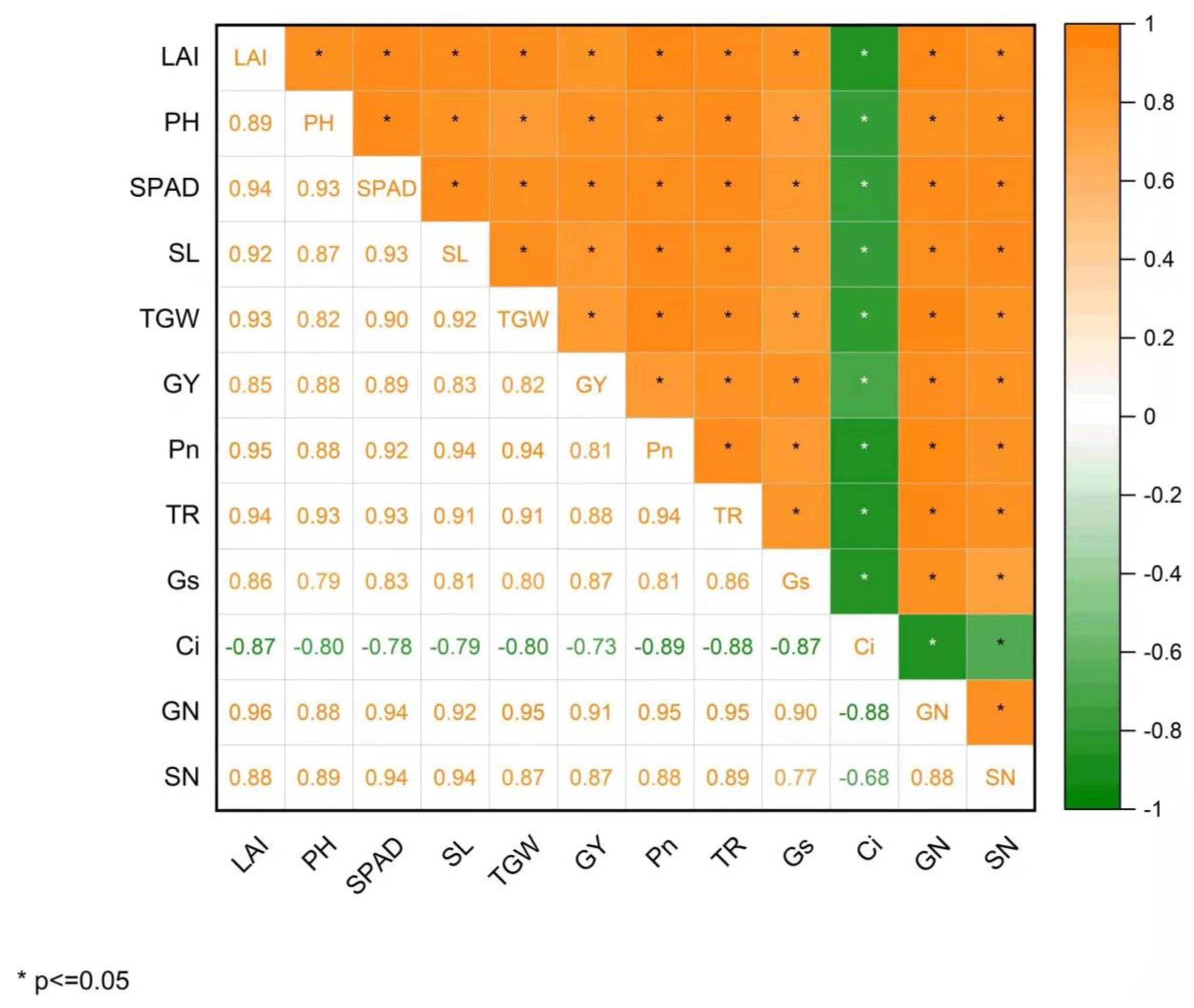
| Year | Treatments | Productive Tillers | Spikelet’s | 1000-Grains Weight (g) | Biological Yield (kg ha−1) | Grain Yield (kg ha−1) |
|---|---|---|---|---|---|---|
| 2018–19 | ||||||
| CK | 262.2 d | 9.54 c | 34.4 d | 7967 d | 3248.9 c | |
| SU | 303.6 c | 10.9 b | 40.9 c | 9989 c | 3743.3 bc | |
| NCU | 328.7 b | 12.8 a | 42.4 b | 10,656 b | 4311.1 ab | |
| SCU | 334.2 a | 13.3 a | 42.8 a | 11,333 a | 4555.6 a | |
| S1 | 300.6 c | 11.5 ns | 40.5 a | 9625 c | 3844.2 b | |
| S2 | 306.9 b | 11.6 ns | 40.1 b | 9975 b | 4000.8 a | |
| S3 | 314.0 a | 11.8 ns | 39.7 c | 10,358 a | 4049.2 a | |
| CK*S1 | 257.0 | 9.4 | 34.8 | 7733 | 3213.3 | |
| CK*S2 | 262.3 | 9.5 | 34.4 | 7967 | 3246.6 | |
| CK*S3 | 267.3 | 9.7 | 34.1 | 8200 | 3286.6 | |
| SU*S1 | 296.0 | 10.7 | 41.4 | 9800 | 3663.3 | |
| SU*S2 | 303.6 | 10.9 | 40.8 | 10,000 | 3856.6 | |
| SU*S3 | 311.3 | 11.1 | 40.4 | 10,167 | 3710.0 | |
| NCU*S1 | 322.0 | 12.7 | 42.8 | 10,100 | 4100.0 | |
| NCU*S2 | 328.0 | 12.9 | 42.4 | 10,600 | 4333.3 | |
| NCU*S3 | 336.3 | 13 | 43.1 | 11,267 | 4500.0 | |
| SCU*S1 | 327.6 | 13.1 | 42.9 | 10,867 | 4400.0 | |
| SCU*S2 | 333.6 | 13.2 | 43.2 | 11,333 | 4566.6 | |
| SCU*S3 | 341.3 | 13.5 | 42.5 | 11,800 | 4700.0 | |
| ANOVA | Nitrogen (N) | <0.001 | <0.001 | <0.001 | <0.001 | 0.0067 |
| Seed rate (S) | <0.001 | 0.226 | <0.001 | <0.001 | <0.001 | |
| N*S | 0.271 | 0.999 | 0.595 | 0.290 | 0.0765 | |
| 2019–20 | ||||||
| CK | 264.0 d | 9.5 c | 34.5 d | 8100 d | 3261.1 c | |
| SU | 305.7 c | 10.9 b | 41.0 c | 10,056 c | 3757.8 bc | |
| NCU | 332.5 b | 12.9 a | 42.6 b | 10,711 b | 4350.0 ab | |
| SCU | 337.1 a | 13.3 a | 43.1 a | 11,411 a | 4590.0 a | |
| S1 | 303.6 c | 11.5 ns | 40.7 a | 9692 c | 3870.8 b | |
| S2 | 309.4 b | 11.7 ns | 40.3 b | 10,067 b | 4030.8 a | |
| S3 | 316.6 a | 11.9 ns | 39.9 c | 10,450 a | 4067.5 a | |
| CK*S1 | 259.0 | 9.4 | 34.9 | 7800 | 3230.0 | |
| CK*S2 | 263.6 | 9.5 | 34.5 | 8100 | 3256.6 | |
| CK*S3 | 269.3 | 9.7 | 34.2 | 8400 | 3296.6 | |
| SU*S1 | 299.0 | 10.7 | 41.5 | 9867 | 3676.6 | |
| SU*S2 | 305.3 | 10.9 | 41.0 | 10,100 | 3866.6 | |
| SU*S3 | 313.0 | 11.1 | 40.6 | 10,200 | 3730.0 | |
| NCU*S1 | 326.0 | 12.8 | 43.0 | 10,167 | 4130.0 | |
| NCU*S2 | 331.6 | 13 | 42.5 | 10,666 | 4400.0 | |
| NCU*S3 | 340.0 | 13.1 | 42.3 | 11,300 | 4520.0 | |
| SCU*S1 | 330.3 | 13.2 | 43.5 | 10,933 | 4446.6 | |
| SCU*S2 | 337.0 | 13.3 | 43.1 | 11,400 | 4600.0 | |
| SCU*S3 | 344.0 | 13.6 | 42.7 | 11,900 | 4723.3 | |
| ANOVA | Nitrogen (N) | <0.001 | <0.001 | <0.001 | <0.001 | 0.0083 |
| Seed rate (S) | <0.001 | 0.235 | <0.001 | <0.001 | 0.0017 | |
| N*S | 0.684 | 0.999 | 0.778 | 0.342 | 0.1343 |
| Year | Treatments | Grain N % | Straw N % | AEN (kg ha−1) | PFPN (kg kg−1) |
|---|---|---|---|---|---|
| 2018–19 | |||||
| CK | 1.19 c | 0.28 d | - | - | |
| SU | 1.70 b | 0.34 c | 4.3 ns | 32.5 ns | |
| NCU | 2.09 a | 0.37 b | 9.2 ns | 37.4 ns | |
| SCU | 2.12 a | 0.40 a | 11.3 ns | 39.6 ns | |
| S1 | 1.76 c | 0.34 c | 7.3 b | 35.2 b | |
| S2 | 1.77 b | 0.35 b | 8.7 a | 36.9 a | |
| S3 | 1.79 a | 0.36 a | 8.8 a | 37.4 a | |
| CK*S1 | 1.19 | 0.28 i | - | - | |
| CK*S2 | 1.19 | 0.28 i | - | - | |
| CK*S3 | 1.20 | 0.29 h | - | - | |
| SU*S1 | 1.69 | 0.33 g | 3.9 | 31.8 | |
| SU*S2 | 1.70 | 0.34 f | 5.3 | 33.5 | |
| SU*S3 | 1.72 | 0.36 e | 3.6 | 32.2 | |
| NCU*S1 | 2.08 | 0.36 e | 7.7 | 35.6 | |
| NCU*S2 | 2.10 | 0.38 d | 9.4 | 37.6 | |
| NCU*S3 | 2.11 | 0.39 cd | 10.5 | 39.1 | |
| SCU*S1 | 2.11 | 0.40 bc | 10.3 | 38.2 | |
| SCU*S2 | 2.12 | 0.41 b | 11.4 | 39.7 | |
| SCU*S3 | 2.14 | 0.42 a | 12.2 | 40.8 | |
| ANOVA | Nitrogen (N) | <0.001 | <0.001 | 0.091 | 0.091 |
| Seed rate (S) | <0.001 | <0.001 | <0.05 | <0.05 | |
| N*S | 0.581 | 0.039 | 0.166 | 0.157 | |
| 2019–20 | |||||
| CK | 1.20 c | 0.29 d | - | - | |
| SU | 1.71 b | 0.36 c | 4.3 ns | 32.6 ns | |
| NCU | 2.11 a | 0.38 b | 9.4 ns | 37.8 ns | |
| SCU | 2.13 a | 0.42 a | 11.5 ns | 39.9 ns | |
| S1 | 1.77 b | 0.35 c | 7.4 b | 35.5 b | |
| S2 | 1.79 a | 0.35 b | 8.9 a | 37.3 a | |
| S3 | 1.80 a | 0.38 a | 8.9 a | 37.6 a | |
| CK*S1 | 1.20 | 0.28 e | - | - | |
| CK*S2 | 1.21 | 0.29 e | - | - | |
| CK*S3 | 1.20 | 0.29 e | - | - | |
| SU*S1 | 1.70 | 0.34 d | 3.8 | 31.9 | |
| SU*S2 | 1.71 | 0.35 d | 5.3 | 33.6 | |
| SU*S3 | 1.73 | 0.38 c | 3.7 | 32.4 | |
| NCU*S1 | 2.09 | 0.37 c | 7.8 | 35.9 | |
| NCU*S2 | 2.12 | 0.37 c | 9.9 | 38.2 | |
| NCU*S3 | 2.12 | 0.40 b | 10.6 | 39.3 | |
| SCU*S1 | 2.11 | 0.41 b | 10.5 | 38.6 | |
| SCU*S2 | 2.13 | 0.41 b | 11.6 | 40.0 | |
| SCU*S3 | 2.15 | 0.43 a | 12.4 | 41.0 | |
| ANOVA | Nitrogen (N) | <0.001 | <0.001 | 0.099 | 0.099 |
| Seed rate (S) | 0.002 | <0.001 | <0.05 | <0.005 | |
| N*S | 0.266 | 0.007 | 0.256 | 0.251 |
Disclaimer/Publisher’s Note: The statements, opinions and data contained in all publications are solely those of the individual author(s) and contributor(s) and not of MDPI and/or the editor(s). MDPI and/or the editor(s) disclaim responsibility for any injury to people or property resulting from any ideas, methods, instructions or products referred to in the content. |
© 2023 by the authors. Licensee MDPI, Basel, Switzerland. This article is an open access article distributed under the terms and conditions of the Creative Commons Attribution (CC BY) license (https://creativecommons.org/licenses/by/4.0/).
Share and Cite
Shoukat, M.R.; Bohoussou, Y.N.; Ahmad, N.; Saleh, I.A.; Okla, M.K.; Elshikh, M.S.; Ahmad, A.; Haider, F.U.; Khan, K.S.; Adnan, M.; et al. Growth, Yield, and Agronomic Use Efficiency of Delayed Sown Wheat under Slow-Release Nitrogen Fertilizer and Seeding Rate. Agronomy 2023, 13, 1830. https://doi.org/10.3390/agronomy13071830
Shoukat MR, Bohoussou YN, Ahmad N, Saleh IA, Okla MK, Elshikh MS, Ahmad A, Haider FU, Khan KS, Adnan M, et al. Growth, Yield, and Agronomic Use Efficiency of Delayed Sown Wheat under Slow-Release Nitrogen Fertilizer and Seeding Rate. Agronomy. 2023; 13(7):1830. https://doi.org/10.3390/agronomy13071830
Chicago/Turabian StyleShoukat, Muhammad Rizwan, Yves N’Dri Bohoussou, Naeem Ahmad, Ibrahim A. Saleh, Mohammad K. Okla, Mohamed S. Elshikh, Adeel Ahmad, Fasih Ullah Haider, Khuram Shehzad Khan, Muhammad Adnan, and et al. 2023. "Growth, Yield, and Agronomic Use Efficiency of Delayed Sown Wheat under Slow-Release Nitrogen Fertilizer and Seeding Rate" Agronomy 13, no. 7: 1830. https://doi.org/10.3390/agronomy13071830
APA StyleShoukat, M. R., Bohoussou, Y. N., Ahmad, N., Saleh, I. A., Okla, M. K., Elshikh, M. S., Ahmad, A., Haider, F. U., Khan, K. S., Adnan, M., Hussain, Q., & Riaz, M. W. (2023). Growth, Yield, and Agronomic Use Efficiency of Delayed Sown Wheat under Slow-Release Nitrogen Fertilizer and Seeding Rate. Agronomy, 13(7), 1830. https://doi.org/10.3390/agronomy13071830











